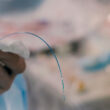This study demonstrated that coronary angioplasty does not entail any benefit in chronic stable angina over optimal medical therapy in those with impaired ventricular function (EF >35%) with extensive coronary artery disease and viable myocardium. Dr. Divaka Perera performed a subanalysis of said study. At the time of the study, the amount of viability and<a href="https://solaci.org/en/2023/03/08/acc-2023-subanalysis-of-the-revived-bics-study2/" title="Read more" >...</a>
ACC 2023 | YELLOW III Study. Effect of Evolocumab on Coronary Plaque Characteristics in Stable Coronary Artery Disease
Dr. Kini presented the results of the YELLOW III Study where she analyzed the effect of evolocumab on coronary plaque in patients with stable coronary artery disease. The study included 137 patients who underwent coronary angioplasty to the culprit vessel and endovascular imaging (OCT, NIRS/IVUS) to non-obstructive lesions (30%-50%). If their plaque was lipid-rich (defined<a href="https://solaci.org/en/2023/03/08/acc-2023-yellow-iii-study-effect-of-evolocumab-on-coronary-plaque-characteristics-in-stable-coronary-artery-disease/" title="Read more" >...</a>
ACC 2023 | TRILUMINATE Pivotal: Edge-to-Edge Treatment in Patients with Tricuspid Regurgitation
Tricuspid regurgitation is a common and impairing disease. Optimal medical therapy (OMT) is limited, valve surgery is complex, and mortality is not low. Dr. Paul Sorajja presented the results of the Pivotal Triluminate study to demonstrate the safety and efficacy of edge-to-edge treatment (transcatheter edge-to-edge repair, TEER) in tricuspid regurgitation. Three hundred and fifty patients<a href="https://solaci.org/en/2023/03/08/acc-2023-triluminate-pivotal-edge-to-edge-treatment-in-patients-with-tricuspid-regurgitation/" title="Read more" >...</a>
ACC 2023 | TAVR in Low Risk Patients: 3-Year Outcomes
At present, transcatheter aortic valve replacement (TAVR) has become the gold standard in the US, regardless surgical risk. The current ACC and AHA guidelines recommend that a Heart Team make the decision for 65 to 80-year-old patients with aortic stenosis. In low risk patients, fast recovery and short term benefits of TAVR should be weighed<a href="https://solaci.org/en/2023/03/08/acc-2023-tavr-in-low-risk-patients-3-year-outcomes/" title="Read more" >...</a>
Left Main Revascularization: 12 Year Registry in Canada
The current indication for severe left main lesion continues to be coronary artery bypass graft surgery (CABG) but percutaneous coronary intervention (PCI) has come far in this territory thanks to increasing operator experienced and the use of IVUS during procedures. At present, left main disease have a Class IIa indication in the American guidelines when<a href="https://solaci.org/en/2023/03/02/left-main-revascularization-12-year-registry-in-canada/" title="Read more" >...</a>
Rivaroxaban in Acute Coronary Syndrome
Acute coronary syndromes (ACS) involve high mortality risk, especially ST elevation ACS. Their treatment is based on reperfusion, dual antiplatelet therapy (DAPT) and anticoagulation, with enoxaparin (1 mg/kg twice a day) as the preferred anticoagulant according to the contemporary guidelines. 2.5 mg or 5 mg doses of rivaroxaban might be valid alternative treatments for this<a href="https://solaci.org/en/2023/02/23/rivaroxaban-in-acute-coronary-syndrome/" title="Read more" >...</a>
Can Drug Coated Balloon Be a Valid Option for Small Vessels?
One of the challenges of percutaneous coronary interventions (PCI) are <2.5 mm vessels, since complications and restenosis complications rate are higher than with >3.0 mm vessels. Drug Coated Balloons (DCB) can be a useful tool, but their efficacy and safety [vs. plain old balloon angioplasty] remains unclear. PEPCAD China SVD is a prospective and multicenter<a href="https://solaci.org/en/2023/02/06/can-drug-coated-balloon-be-a-valid-option-for-small-vessels/" title="Read more" >...</a>
What Is the Best Strategy for Moderately Complex Femoropopliteal Lesions?
At present, PCI is the preferred treatment for femoropopliteal lesions and drug coated balloons (DCB) have shown good performance. However, they have not yet been shown superior to bare-metal stents (BMS). This study compared randomized trials IN.PACT SFA I/II and IN.PACT JAPAN including 288 patients vs. the prospective Complete SE and DURABILITY II with 483<a href="https://solaci.org/en/2023/01/31/what-is-the-best-strategy-for-moderately-complex-femoropopliteal-lesions/" title="Read more" >...</a>
TAVR and New Onset LBBB
The safety and efficacy of transcatheter aortic valve replacement (TAVR) is already established. However, it still poses a challenge for conduction disturbances, such as the need for pacemaker or new onset left bundle branch block (LBBB). The current rate for the latter ranges from approximately 11% to 19%. In most cases, 50% of LBBB reverses<a href="https://solaci.org/en/2023/01/31/tavr-and-new-onset-lbbb/" title="Read more" >...</a>
IN.PACT Study | Should We Start Using DCBs More Frequently in Cases of Femoropopliteal Disease?
With the new devices (drug-eluting balloons [DEB], drug-eluting stents [DES], and atherotomes) percutaneous treatment is becoming the first line of approach for femoropopliteal disease, especially when dealing with not very long total occlusions. Randomized studies and registries on the use of drug-coated balloons (DCB) in femoropopliteal disease are currently available, but their evolution beyond 2<a href="https://solaci.org/en/2023/01/30/in-pact-study-should-we-start-using-dcbs-more-frequently-in-cases-of-femoropopliteal-disease/" title="Read more" >...</a>






